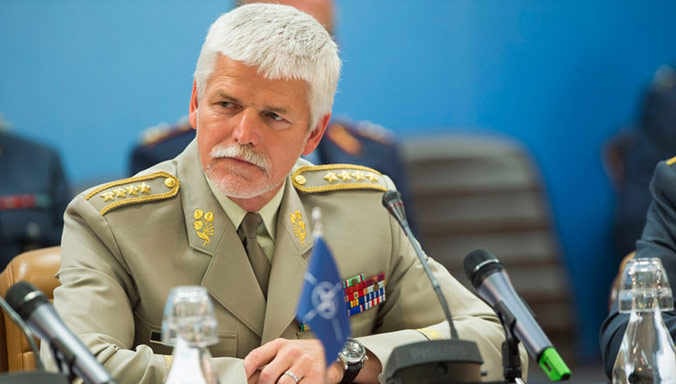
Czech Gen. Petr Pavel, chairman of the NATO Military Committee, told reporters in Washington, D.C., on Oct. 25 the alliance is looking to adjust its command structure in the face of growing threats, most notably from Russia. NATO photo.
NATO wants to adjust its command and force structures in the face of growing threats, following Russia’s recent aggressive behavior, including the 2008 Russo-Georgian War and the 2014 annexation of Crimea, Czech Gen. Petr Pavel, chairman of the NATO Military Committee, told reporters in Washington, D.C., on Wednesday.
“When we talk about Russia the answer will always be complicated because the very relationship with Russia is complicated,” said Pavel. The alliance and Russia continue to battle different perceptions, he said, with NATO seeing Russia’s recent activities as “aggressive” and Russia seeing NATO as the threat.
Pavel said NATO’s current command structure—once about “23,000 strong” at the height of the Cold War, but only about 7,000 today—is no longer sufficient to address the existing threats.
“The assessment of the commanders, and chiefs, and ministers of defense is that this structure was useful and sufficient for a time of peace, but that there are some deficiencies for crisis, and especially for conflict,” said Pavel.
NATO commanders have come up with what the alliance is calling an “outline design,” which identifies and addresses these deficiencies, as well as additional challenges such cyber and hybrid warfare. The plan will be presented to defense ministers in early November and a final decision on what the new command structure will look like will be made during the Feb. 18 defense ministerial meeting in Brussels, said Pavel.
“When we discussed NATO’s adaptation, we deliberately didn’t call it a review because we didn’t want to draft anything on a blank sheet of paper,” said Pavel. “So we started where we are [today], with existing structures and existing resources,” and tried to “adjust to fit the requirements, not to reconstruct entirely.”
The Wall Street Journal reported on Tuesday that NATO is considering the creation of two new commands. One would be focused on improving logistics and supply lines in the event of a potential conflict with Russia, while the other would look to protect sea lanes in the Atlantic and Arctic Oceans used to supply Europe. On Wednesday, Pavel said it’s “premature” to discuss details of the alliance’s proposed plan until the defense ministers are briefed in November. He did acknowledge, however, that “it’s just a matter of time” before NATO presents a “new concept to logistically enable the whole theater.”
In the past, administrative and legislative procedures have greatly slowed the movement of equipment across the continent, but in the past six months there has been “a significant improvement,” said Pavel, though he noted “there are still some challenges.”
NATO also is working to re-establish military communication with Russia. Pavel and his Russian counterpart, Gen. Valery Gerasimov, chief of the Russian General Staff, met face-to-face in September in Azerbaijan. The meeting, which followed a March 3 phone call between the two generals, was “quite open” and both sides tried to keep the discussion focused on “the military level,” to include exercises, defense posture, and military activities, said Pavel.
“My communication with [the] Russian military leader is under a lot of scrutiny from all the nations,” said Pavel. He added, “Before I went to the meeting, I had a clear agenda, and clear mandate from the military alliance.” US Army Gen. Curtis Scaparrotti, head of US European Command and Supreme Allied Commander, Europe, also is slated to meet with Russian military leaders “by the end of the year,” said Pavel.
“There is a will to establish the trust that has been broken over the past few years. I believe we have achieved this initial stage. We have developed, at least, this initial relationship that will allow us to have occasional phone calls and face-to-face meetings on those issues,” he added.